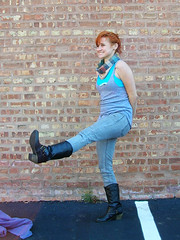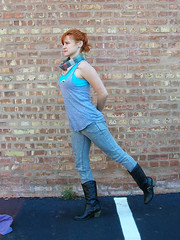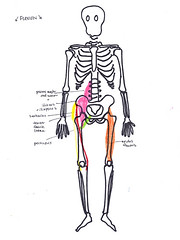Now we're talking business, this is what we're talking about when we talk about MEAT LEGS. I've talked about my quads and my glutes and my hamstrings with the best of them, honestly though with just the vaguest notion of the actual muscles that these magic words invoke. I have been looking forward to being demystified.
What movements happen at this joint?
Flexion is when the angle between the femur and the ilium is decreased by moving them toward each other, and extension is when the angle is increased by moving them away from each other. So at the shoulder it's the angle between the humerus and the scapula; this was so confusing to me when I started studying motion at the joints, and now it seems obvious. Progress! But anyway, flexion at the hip is bringing your thigh forward and extension is bringing it back. In the picture above, Biggie is actually hyperextending her thigh past neutral.
What muscles make these movements happen?
I have never known what people were talking about when they said "hip flexors," now behold the man behind the curtain. The muscles that flex your thigh are your iliopsoas, which is actually made up of the psoas major, psoas minor, and iliacus, sartorius, the "tailor's muscle" that stretches from your pelvis all the way to your tibia and is the muscle that allows you to sit crosslegged, rectus femoris, one of the four muscles that you probably refer to as your "quad," tensor fascia latae, a short muscle at the side of your hip that attaches to the long iliotibial ligament a.k.a. "IT band" that also stretches from pelvis to your tibia, and pectineus, which is more commonly grouped with the hip adductors.
The muscles that extend and hyperextend your thigh are your gluteus maximus, the largest and closest to the surface of your three gluteal muscles, and your three "hamstrings," biceps femoris, semimembranosus, and semitendinosus.
And it all makes sense, right? The flexors are anterior muscles, they contract and pull your thigh forward; the extensors are posterior muscles, they contract and pull your thigh back.
What exercises make these muscles work?
Straight leg situps, high knee running, leg raises, and hanging leg raises work iliopsoas; my iliopsoas is pretty weak, I hate high knees but am getting better at them. Knee raises (lifts) with hip external rotation work sartorius, which is also involved in hip external rotation and knee flexion. Squats, leg presses and also running and jumping rope work rectus femoris. Hanging knee raises, side leg raises, and running work tensor fascia latae. Hanging knee raises, side bottom leg raises, and resisted external rotation work pectineus.
An interesting note about straight leg situps and leg raises: because the psoas muscles are short, they exert a lot of force in lifting the trunk or legs and most people do not have strong enough abdominal muscles to counteract this force and keep the spine in a neutral position. You can feel this when you're doing these exercises and your spine pulls off the ground; you should only do these exercises to the extent that you can keep your spine printed on the ground, to protect your spine and lower back muscles. Pull down with your abdominal muscles to strengthen them.
Squats, plyos, and also cycling, stair climbing, and jumping rope work gluteus maximus. Cycling also works hamstrings, as do hamstring curls.
Hamstrings are the primary movers in low-intensity activities such as walking, whereas glutes are the primary movers in high-intensity activities such as sprinting and stair climbing. Also at least 90 degrees of hip flexion is a guideline for activating the glutes.
The more I write up these exercises, the more I would not organize exercises like this. I would never think about working myself out muscle by muscle, I would do it by groups or by movement or I would train to be a champion jumproper and might want to know what muscles were involved. I have to know these for the test, though.



